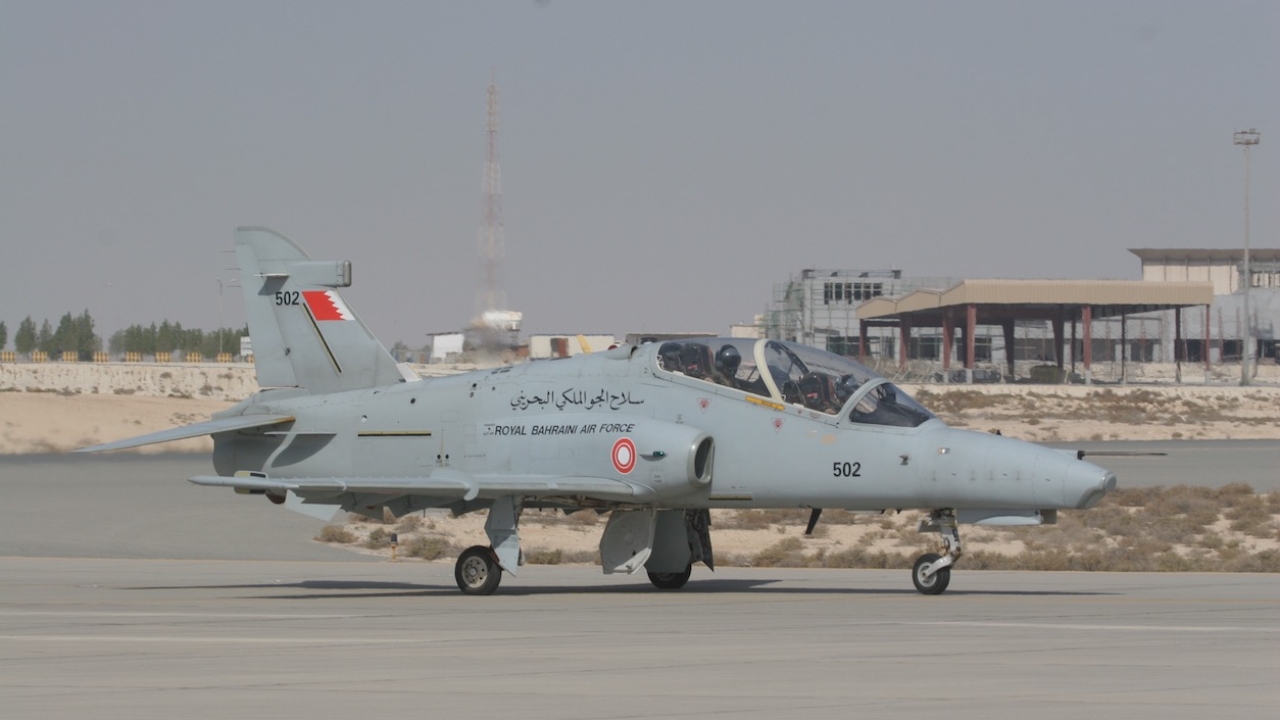Can Bahrain plug its pilot gap?
Alan Warnes looks at Bahrain’s military training needs and asks whether a new approach is needed.

Tried and tested: BAE Systems could bolster the flying training the RBAF Hawk brings by increased synthetics and artificial intelligence. Picture: Alan Warnes.
The Royal Bahraini Air Force (RBAF) looks set to modernise its current flying training system as additional F-16s are added to its inventory.
With the first of 16 brand new F-16C/D Block 70s set to be delivered in early-2024, to augment the 20 F-16C/D Block 40s already in use, a solution needs to be found to cope with the increased need for more pilots.
In recent years, the RBAF’s six Hawk Mk 128s have been heavily used to ensure there are enough qualified F-16 pilots
With no basic flying training aircraft, student pilots are currently being trained in the UAE and Saudi Arabia, before getting to the 4 Squadron Hawks. Until recently, they used to go to Egypt too, which meant the standards of airmanship varied, which only exacerbated the flying training issues.
In late-2021, the RBAF commander, Major General Hamad al Khalifa, said there were no plans to relaunch a basic flying training programme having retired the Slingsby Fireflies due to the lack of air space to train in. So new options might be needed.
BAE Systems believe that it can solve the RBAF’s issues by offering new methods of working with the Hawks, delivered between 2003-08.
At the Bahrain International Airshow (BIAS) last November, the British company was showcasing its new training concept alongside its two technology partners, Lincoln-based Inzpire and Irish company, VRAI (Virtual Reality and Artificial Training) to deliver the right impact and value for money.
BAE Systems training strategy manager, Tim Colebrooke, believes that the cutting-edge radar and datalinks the new F-16s bring, will highlight a gap in the current training. “We can bridge that by using technology partnerships to meet the demand and help the uplift in the number of qualified RBAF pilots,” he said.
“We feel the Hawk is still relevant in flying training because we don’t let it just fly without any necessary upgrades. As a company, we feel synthetics plays a big part – you don’t just get the assets, the air space and the ranges to grow the student into a capable front line pilot.”
Alistair Howard, business development manager of Inzpire, was keen to stress the company’s military pedigree: “80% of our employees are former military, and that brings experience across all domains, specifically spanning flying training up to the operational end. We have massive experience delivering collective training in the UK. What we are trying to do is assist BAE Systems with delivering operational-level training.”
The other technology partner, VRAI, specialises, as its name suggests, in virtual reality and artificial intelligence. It has systems that monitor the biometrics of the pilots’ performance – how they perform alongside/versus peers – and instructors can look in to see how the general population of students are performing.
Colebrooke explained: “The day that we start the aptitude testing and down-selecting, we start to measure their attitude to flying, and we take that data and set about ensuring they can overcome their difficulties. By tailoring the training, it doesn’t mean the first person has to wait for the last – you have to develop to the standard by the end of course.”
Meanwhile, Italian aerospace giant, Leonardo, is taking a different approach, as the VP Middle East and North Africa, Italo Rossini, explained: “We believe we have the best solution with the M-346 integrated training system. Some of the roles that the M-346 advanced jet trainer can fulfil will reduce the training carried out on new expensive fighters.
“Air forces have the potential to buy the aircraft or send students to the International Flight Training School – a partnership between the Italian Air Force and Leonardo.
“But it is not just about the cost-savings, it is also about the aircraft’s flying characteristics, its fly-by-wire capabilities and aerodynamics that an older training system [like the Hawk] cannot fulfil.”
The M346 could be an ideal solution for the RBAF, which does not have the air space to carry out its own training. As Rossini said: “The RBAF could acquire the aircraft and base them at an overseas location or send students to the IFTS.”
Stay up to date
Subscribe to the free Times Aerospace newsletter and receive the latest content every week. We'll never share your email address.

